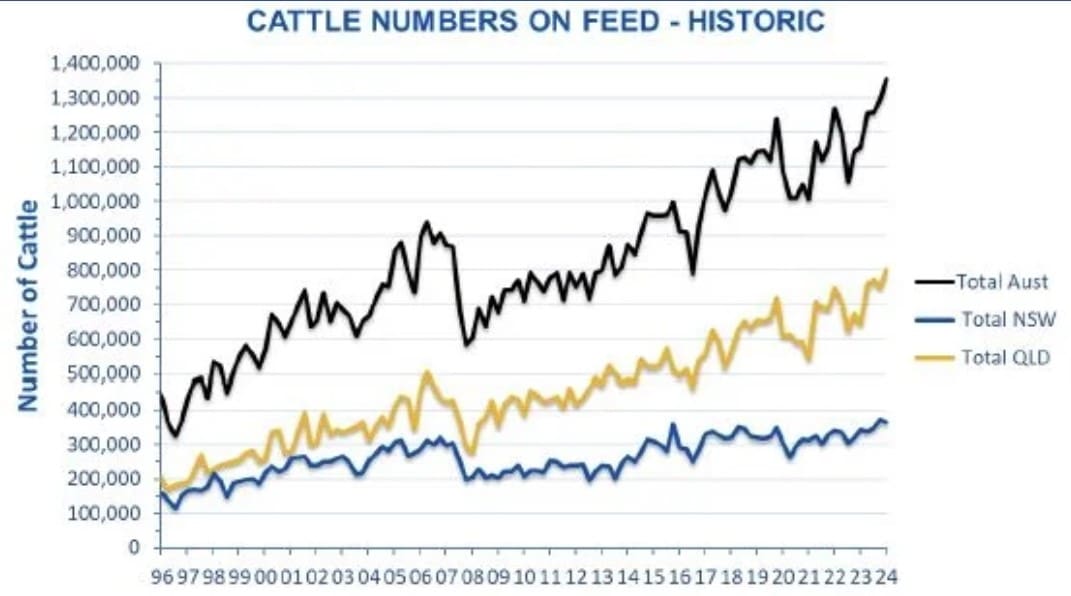
Click on image to enlarge
NUMBERS on feed across the Australian grainfed industry hit a new record high during the March quarter, totalling 1.354 million head.
The new milestone adds a further 60,000 head on top of the previous December quarter record.
The March quarter survey conducted by the Australian Lot Feeders Association and Meat & Livestock Australia shows a sixth consecutive quarterly lift in numbers of cattle on feed, driven by new record highs in Queensland, the largest lotfeeding state, and South Australia.
Much of the industry momentum is captured in Beef Central’s recent Top 25 Lotfeeders report (click here to access), mostly driven by heavy investment in expansion at existing feedlot sites.
As can be seen in the graphs below, the quarterly numbers on feed report now splits results into two graphs – the two largest feeding states and the national total, and the three smaller feeding states, using different X axis ranges:
ALFA president Barb Madden said positive trading conditions over the first quarter of 2024 had been the biggest driver of increased cattle numbers entering feedlots.
“Prices for feed grain and feeder steers have provided for supportive market conditions for cattle placement,” Mrs Madden said.
Queensland’s numbers on feed at the end of March leapt by 52,200 head or 7pc from December to a new record of 802,451 head or more than 59pc of the nation’s total.
Victoria, South Australia and Western Australia also rose, by 14pc 11pc and 2pc respectively, while NSW numbers dropped 2pc across the quarter.
National capacity remained stable at 1.59 million head, but it was in yard utilisation rates where the growth occurred – lifting by 4pc, to 85pc in the March quarter. Utilisation rates struggle to get much higher than this figure, because of pen cleaning, maintenance and other issues.
Grainfed cattle turnoff figures lifted 14pc during the March quarter to 761,550 head with every state having higher turnoff compared with December.
Feeder steer and feedgrain prices
MLA’s senior market information analyst Erin Lukey said the supply of feeder steers had been a factor influencing the numbers of cattle on feed.
Throughput in MLA’s feeder steer indicator (based on NLRS-reported saleyards transactions) lifted 13pc on last quarter, resulting in the largest numbers since March 2018, Ms Lukey said.
“Individually, most states experienced lifts to feeder steer transactions, with only WA reducing its throughput when compared to the previous quarter and the corresponding period last year,” she said.
A softening of feedgrain prices over the reporting period, paired with feeder cattle prices remaining relatively low, supported more favourable margins for lotfeeders, Ms Lukey said.
Grainfed beef exports remained stable for the first quarter of 2024, with 83,949 tonnes of Australian grainfed beef exported.
While quarter-on-quarter export numbers have remained level, grainfed beef export tonnages represented 30pc of all beef exports during the quarter, up 2pc from the previous reporting period.
This trend is expected to continue in the foreseeable future as current cattle on feed move through their feed programs, Ms Lukey said.



HAVE YOUR SAY